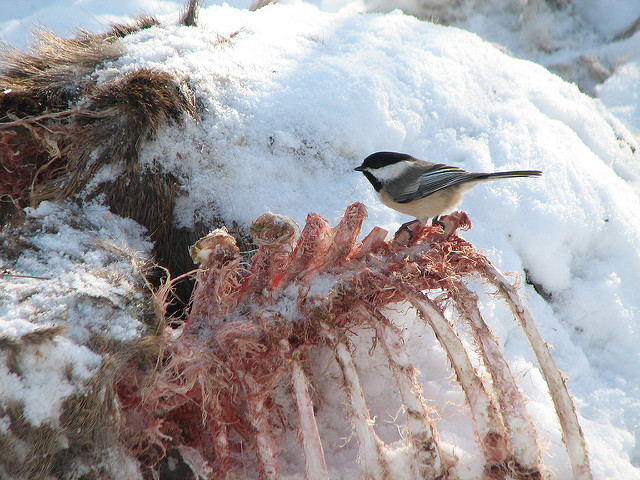For a few nights, the coyotes had been howling and yipping close to the house. We’d even heard foxes barking much closer than usual. One morning, after the evening snow had created perfect tracking conditions, we wandered down to see what we could find.
First, a lone coyote’s tracks crossed the driveway. It was a young one who left a fairly small impression of a perfect canine foot. On the other side of the driveway, more coyote paths joined, showing prints made by larger, full-sized animals. A fox traveled the same path, its indistinct perfect-stepping trail much smaller. Soon it was a veritable interstate system with well-trod trails crisscrossing back and forth from woods to brushy pasture.

As the traffic increased, hints of the cause appeared. A few strands of fur gave way to clumps, and turning the corner into a cul-de-sac of Multiflora Rose bushes a dead, and now mostly eaten, buck. Scavenger traffic was intense and individual footprints were hard to make out. The antler closest to the ground had already been chewed to nothing by rodents keeping busy under the snow. The body cavity was empty and ribs shown in the sunlight.
Mystery solved. But… the day was too beautiful to not enjoy. We continued wandering about, noticing tracks of songbirds under bushes and tunnels in the snow. We stumbled upon the tracks of a small mammal, clawed feet but with a stride too long to be a skunk. We concluded it was a young fisher investigating the backyard, the sugarbush, the firewood piles, and then heading across the field.
Other tracks we found that day included house cat, skunk, and adult fisher. This tracks were actually sort of scary. As they passed right between the house and the barn, I was tense worried that they circled back to the chicken coop. Relieved, as I followed them I discovered that they didn’t. The fisher curved slightly toward the blueberries and then directly headed to the woods up the hill.
Curious, I tracked to see where he (I’m assuming with no evidence at all) came from. Back through the front yard, across the street, and down to the edge of the creek. Despite the sun, it was still cold and I didn’t fancy a trip across the creek and so I imagined that he came from the woods on the other side, perhaps headed to my side of the creek in search of porcupines to snack on.
Later that same weekend, we stopped at a creek on the state line and hiked in on an old road. A human had been their earlier with a canine companion, and the dog’s tracks led us almost immediately to another young buck, mostly consumed. The tracks for that had been snowed over, but I stood for a while and watched another scavenger come in and take advantage of the easy meal.
Most people don’t think of songbirds as consumers of carrion, but the Black-capped Chickadee is a frequent visitor to the remains left after the bigger and furred scavengers have taken their share. There was a small flock and they didn’t seem to mind me at all. Swooping in low, they would perch on branches to survey the scene and then drop expertly to perch on the ribs, alertly watching between nibbling bits of fat and meat left on the bones. It sound grisly, but this is an excellent adaptation and partnership in nature. Larger scavengers can open carcasses that smaller ones cannot, and these groups of animals all understand hardship in winter and share the bounty.
Further up the trail there were bird tracks. Originally we thought Ruffed Grouse, but then we questioned if it couldn’t be a pheasant. Unlikely, but the stride was long for a grouse. In any case, the bird walked the road for a long time before heading into the brush. The tracks were entertaining, as the conditions had been perfect to allow a light layer of snow to cover smoothly frozen puddles. Consequently the bird slipped and slid as it traversed the road.
Other tracks that day were deer – some of the smallest deer tracks I have ever seen in February – squirrel, mouse, and turkey. There was evidence of beaver, but no tracks. Mystery holes were melted in the snow, whether shrew, mouse, or vole it is hard to say. Later there were teeny, tiny, bounding tracks that we eventually concluded must belong to a tiny weasel. The stride was remarkable, and it was a busy, busy creature! It also slid on the ice, but leaped across fields, tunneled under bushes, and sometimes disappeared into holes.
At the end of the walk we flushed a dozen grouse from the hillside where they were, undoubtedly, soaking up the sunshine. It was a wonderful winter walk, and a good reminder that despite the cold, it is an active winter world out there. As February ends, and March begins, I encourage you to seize the last chance to see the stories written in the snow. Audubon’s trails are a great place to start. Spring will be here soon, and brings its own stories. But while the snow still covers the ground, take a moment to read it.
Audubon Community Nature Center builds and nurtures connections between people and nature. ACNC is located just east of Route 62 between Warren and Jamestown. The trails are open from dawn to dusk as is Liberty, the Bald Eagle. The Nature Center is open from 10 a.m. until 4:30 p.m. daily except Sunday when it opens at 1 p.m. More information can be found online at auduboncnc.org or by calling (716) 569-2345.
Sarah Hatfield is Education Coordinator at ACNC.


Recent Comments